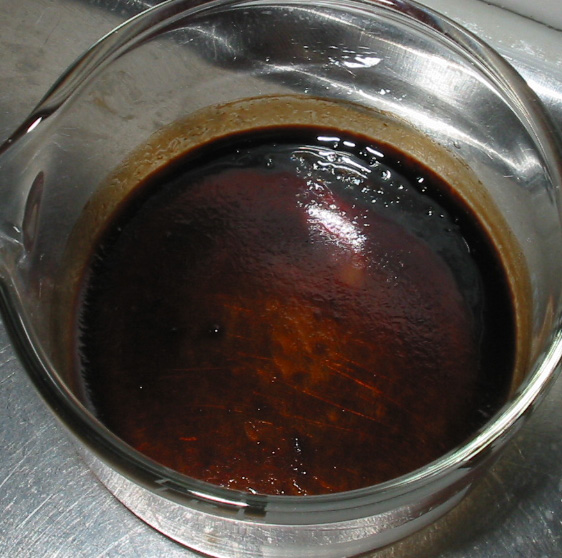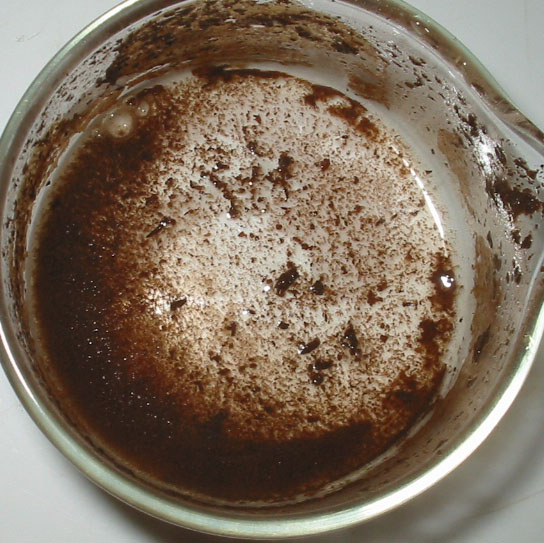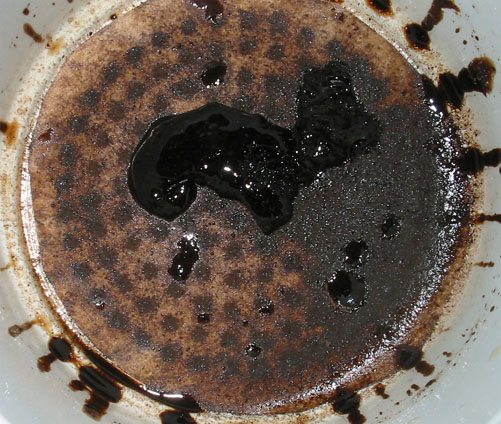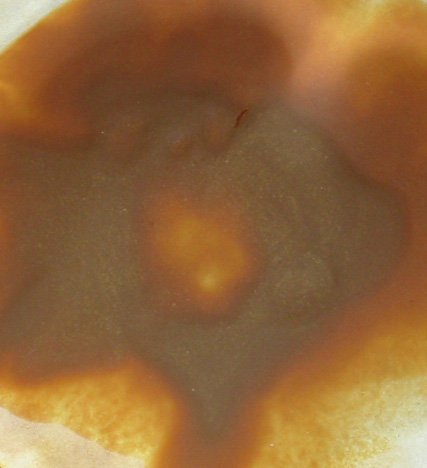| Pages:
1
2
3 |
KidCurry
Hazard to Self
 
Posts: 54
Registered: 12-3-2004
Location: Europe
Member Is Offline
Mood: No Mood
|
|
Aromatic bromination with NBS
From an old post on The Hive:
| Quote: | From a bottle that was labeled as "ricuarte's 2,4-dimethoxyphenylethylamine HCl" there was 5 gram (23 mmol) dissolved into 35 ml GAA.
To this mixture was added 4,9 gram (28 mmol) NBS which caused the solution to turn deeply red.
After covering the RBF with foil and placing a stopper on the flask the whole was stirred for 30 minutes. The precipated crystaline mass was filtered
off and washed twice with ethyl acetate, another wash with H2O caused the solids to dissolve, the pH was adjusted to > 11 and the organic layer was
extracted with 3x 30 ml EtO2, after removal of the solvents the residual oil was dissolved in 20 ml IPA and the solution was neutralized with dry HCl
in IPA. The solids that formed where washed once with EtO2 and filtered to provide a crop of white crystals weighing 5,38 gram.
An attemp to recrystalize the solids from IPA/Toluene (10ml ipa:5ml Toluene / gram) did not dissolve all sollids, even the addition of more IPA caused
the solution to stay turbid. After allowing the solution to slowly cool down to RT the whole was refrigerated overnight providing 4,86 gram of what is
beleived 4-bromo-2,4-dimethoxyphenylethylamine HCl (71 %) with a mp of 235-237°C, a marquis reagent test gave a a dark green spot.
|
Tried out. Dissolved freebase (not salt) in GAA, added NBS and stirred for 30 minutes. Nothing, stirred for another hour, nothing. Stirred it
overnight, nothing. So, is 30 minutes actually a typo for 30 hours? All other posts I've seen with NBS bromination mentions a reaction time of
atleast 4-12 hours. What would be a wise approach now? Maybe apply some heat and wait atleast another 12 hours? If no solids appear do an A/B
extraction?
|
|
|
transformer
Harmless

Posts: 45
Registered: 30-6-2005
Member Is Offline
Mood: No Mood
|
|
What substrate did you use? 30 minutes was not a typo, if no solids apear try an a/b.
[Edited on 4-8-2005 by samsung]
|
|
|
KidCurry
Hazard to Self
 
Posts: 54
Registered: 12-3-2004
Location: Europe
Member Is Offline
Mood: No Mood
|
|
2C-H, from Al/Hg reduction of 2,5-DMNS (not distilled). Unknowned amoumt, but was assumed to be about 5-6g. Dissolved in 50ml GAA.
Some isopropanol might have slipped in since I didn't want to burn the phenethylamine when stripping the IPA off.
I tried starting the reaction with heat, but still no solids. Did you recrystallise your NBS before use? I will have to wait to do an a/b for a few
days, do you thinks it's ok?
[Edited on 4-8-2005 by KidCurry]
|
|
|
enima
Hazard to Self
 
Posts: 98
Registered: 1-12-2004
Member Is Offline
Mood: No Mood
|
|
distill/recrystallize your amine first, get a known amount before you brominate. You will have product of higher purity and will know the exact amount
of bromine to use.
The yields on brominations are generally higher if the starting compound is of high purity.
|
|
|
KidCurry
Hazard to Self
 
Posts: 54
Registered: 12-3-2004
Location: Europe
Member Is Offline
Mood: No Mood
|
|
Yes, I know but perfect yield was really not an issue here and I didn't have the possibility to A/B the amine or distill it at the moment so I
just proceeded rather than waited. Dirty 2C-H have been known to brominate fine before so..
(But maybe I have to pay for my lazyness now  ) )
[Edited on 4-8-2005 by KidCurry]
|
|
|
KidCurry
Hazard to Self
 
Posts: 54
Registered: 12-3-2004
Location: Europe
Member Is Offline
Mood: No Mood
|
|
Took out a few milliliters and evaporated in a small beaker. The question is if this is 2C-B.HBr and succinimide, just NBS or something completely
else. 
EDIT: The addition of some GAA dissolved almost all formed crystals, except maybe 1mg (really small amount) and since 2C-B.HBr is supposed to be
insoluble in GAA:
1) Bromination failed.
2) Freebase of 2C-B was the product.
Why?
Hm.
[Edited on 4-8-2005 by KidCurry]

|
|
|
KidCurry
Hazard to Self
 
Posts: 54
Registered: 12-3-2004
Location: Europe
Member Is Offline
Mood: No Mood
|
|
More woes:
Added a few drops of water to see if everything dissolved, but instead I got this mess. What the hell has happened here?

|
|
|
enima
Hazard to Self
 
Posts: 98
Registered: 1-12-2004
Member Is Offline
Mood: No Mood
|
|
How pure was your nitroethene/nitrostyrene before the Al/Hg reduction. NBS brominations are fairly easy.
|
|
|
KidCurry
Hazard to Self
 
Posts: 54
Registered: 12-3-2004
Location: Europe
Member Is Offline
Mood: No Mood
|
|
Well, it was pure (I think). Recrystallised from IPA. Long fine needles, coloured intensly orange. Should a NBS bromination in GAA form the
hydrobromide salt? If not, the product might be in solution and an A/B workup is in order.
The result of the reduction can be seen here: http://www.sciencemadness.org/talk/viewthread.php?action=att...
This was what was dissolved in GAA, together with NBS.
There's basically three "errors" possible:
1) A few ml's of IPA still left from the reduction.
2) I calculated a 1.5 molar excess of NBS assuming the weight of nitrostyrene was 5-6g. Maybe it was too much?
3) NBS wasn't recrystallised before use (as someone advised in a post on The Hive). Yellowish powder.
Don't know how this will affect things. But if bromination took place, and the HBr salt was the product it COULD dissolve in the IPA left in the
mix. BUT, it's a maximum of 10ml's and that would probably not dissolve more than a gram of 2C-B (?). So, where's the rest of it?
EDIT: Basified a small amount of the solution, and it resulted in a brown mixture with some not very cool blackish insolubles (same as seen in the
last picture). In other words, I'm probably fucked. 
[Edited on 4-8-2005 by KidCurry]
|
|
|
transformer
Harmless

Posts: 45
Registered: 30-6-2005
Member Is Offline
Mood: No Mood
|
|
If the freebase or 2,5-dimethoxy acetate gets brominated at the 4th position at all instead of forming some n-bromo compound then chances are good
that the 2c-b in the post reaction will contain a lot of different salts from which i guess the more GAA soluble 2c-b acetate is the most abundant.
Try to use the hydrochloride salt next time, im not sure exactly how soluble 2c-b acetate is in GAA but rumor says 2c-b hcl is pretty insoluble in RT
GAA and don't skip on the a/b here, good luck!
| Quote: | Originally posted by KidCurry
Well, it was pure (I think). Recrystallised from IPA. Long fine needles, coloured intensly orange. Should a NBS bromination in GAA form the
hydrobromide salt? If not, the product might be in solution and an A/B workup is in order.
The result of the reduction can be seen here: http://www.sciencemadness.org/talk/viewthread.php?action=att...
This was what was dissolved in GAA, together with NBS.
There's basically three "errors" possible:
1) A few ml's of IPA still left from the reduction.
2) I calculated a 1.5 molar excess of NBS assuming the weight of nitrostyrene was 5-6g. Maybe it was too much?
3) NBS wasn't recrystallised before use (as someone advised in a post on The Hive). Yellowish powder.
Don't know how this will affect things. But if bromination took place, and the HBr salt was the product it COULD dissolve in the IPA left in the
mix. BUT, it's a maximum of 10ml's and that would probably not dissolve more than a gram of 2C-B (?). So, where's the rest of it?
EDIT: Basified a small amount of the solution, and it resulted in a brown mixture with some not very cool blackish insolubles (same as seen in the
last picture). In other words, I'm probably fucked. 
[Edited on 4-8-2005 by KidCurry] |
|
|
|
Sandmeyer
National Hazard
   
Posts: 784
Registered: 9-1-2005
Location: Internet
Member Is Offline
Mood: abbastanza bene
|
|
Bromine (Br2) is the brominating agent when you use NBS -- only in this case it is slowly formed in situ, unsing NBS hence pose no difference from
'oridnary' bromine bromination.
|
|
|
epck
Harmless

Posts: 27
Registered: 27-7-2005
Member Is Offline
Mood: confused
|
|
As per normal I am slightly confused by the mechanism by which the reaction is proceding. According to my OChem book the rxn procedes through benzyl
radical intermediate step and produces Br2 which, as Sandmeyer pointed out, does the actual bromination. However, in the mechanism in my book the
akyl side chain is bromonated at the benzylic position. For example, propylbenzene->(1-bromopropyl)benzene.
So what causes the difference in bromine position? Does the presence of the methoxy groups stabilize the intermediate needed produce the 4-bromo?
Is it because there is a ethylamine instead of a alkane? Does the GAA catalyze this reaction? I seem to remember reading about using perchloric acid
to catalyze a similar reaction but I wouldn't think GAA would do this.
|
|
|
KidCurry
Hazard to Self
 
Posts: 54
Registered: 12-3-2004
Location: Europe
Member Is Offline
Mood: No Mood
|
|
Sandmeyer: If that is the case, wouldn't the bromination in GAA result in the HBr-salt falling out as a solid?
|
|
|
Sandmeyer
National Hazard
   
Posts: 784
Registered: 9-1-2005
Location: Internet
Member Is Offline
Mood: abbastanza bene
|
|
| Quote: | Originally posted by epck
As per normal I am slightly confused by the mechanism by which the reaction is proceding. According to my OChem book the rxn procedes through benzyl
radical intermediate step and produces Br2 which, as Sandmeyer pointed out, does the actual bromination. However, in the mechanism in my book the
akyl side chain is bromonated at the benzylic position. For example, propylbenzene->(1-bromopropyl)benzene.
|
Mechanism, picture from http://www.brynmawr.edu/Acads/Chem/mnerzsto/bettermechanism....

It simply works by providing small concentrations of Br2, small concentration of HBr is enough to protonate the amide and thereby get the reaction
going, then every addition produce some HBr which liberate more Br2. HBr is also produced in the ring-bromination step.
[Edited on 6-8-2005 by Sandmeyer]
|
|
|
epck
Harmless

Posts: 27
Registered: 27-7-2005
Member Is Offline
Mood: confused
|
|
That part of the mechanism was understood. Sorry I wasn't clearer on my question. The unclear bit was why the Br ended up on the benzene ring
instead of on the number one carbon on the ethylamine as my OChem book indicated it should.
After some reading (which I should have done in the first place) I think it is the presence of the methoxy groups which directs the Br to the fourth
position. Pretty sure, I think.
Sandmeyer -thank you very much.
|
|
|
KidCurry
Hazard to Self
 
Posts: 54
Registered: 12-3-2004
Location: Europe
Member Is Offline
Mood: No Mood
|
|
Ok. Decided to do the A/B today.
Basification left a mess, and cleaning it up sucked. Extracted with 3x30ml xylene which was dried with KOH and then gassed with HCl. Became very happy
when something started to fall out, became pretty sad when filtering and saw that the crystals were chocolaty brown(!). Washed with xylene but did not
get rid of coloration. Drying now, which actually makes it turn into very tan brown/off-white. Who knows what it is, most probably not 2C-B tho. 

|
|
|
KidCurry
Hazard to Self
 
Posts: 54
Registered: 12-3-2004
Location: Europe
Member Is Offline
Mood: No Mood
|
|
Picture of product, while still wet:

|
|
|
Sandmeyer
National Hazard
   
Posts: 784
Registered: 9-1-2005
Location: Internet
Member Is Offline
Mood: abbastanza bene
|
|
will you try the product for activity?
I think NBS is a good bromination alternative to elemental bromine which at leat I can't purchase where I live  . I hope you get the reaction to work and report when fully done. . I hope you get the reaction to work and report when fully done.
|
|
|
KidCurry
Hazard to Self
 
Posts: 54
Registered: 12-3-2004
Location: Europe
Member Is Offline
Mood: No Mood
|
|
Maybe, depending on how it looks after complete drying and recrystallisation from IPA (but it's probably not more than 500-1000mg in there, so if
it really is 2C-B the yield was crap). 
I have no problems aquiring bromine, but I really like to avoid it if I can. Will try the bromination again when I find the time, but on the
hydrochloride salt instead of the unpurified freebase.
[Edited on 8-8-2005 by KidCurry]
|
|
|
xwinorb
Hazard to Others
  
Posts: 100
Registered: 9-8-2005
Member Is Offline
Mood: No Mood
|
|
Hey Kid Curry :
SWIX has sucessfully made 2C-B. Interested in helping and learning more about bromination. What he did :
Purchased 100 g 2,5-DMBA.
Henry condensation with AmAc yielded 40 g nitrstyrene from 50 g 2,5-DMBA.
Zinc-HCl reduction yielded aprox 24 g 2C-H.HCl.
Distilled with short path to get 20 g 2C-H.HCl
Tried to brominate with ammonium bromide and H2O2 in AcOH. This one failed, SWIX thinks becasue the bromination is via BrOH, not Br2.
Next tried to purchase NBS, but was unable to.
Then tried Chromic bromination, with less water ( just enough to dissolve NaBr ) and dripped in all at once. Over freebase on AcOH ( did it once on
the HCl salt, but looks dirtier and lower yielding, I suggest not to try it on the HCl salt but on the freebase ).
As soon as dripped in the Br2 solution, temperature went to 50 C, then slowly back to RT. Basified, with ice cooling, slowly. Noticed oily layer on
top. Extracted with toluene. Dripped in HCl till xtals no longer forming. Added about 2X cool water, filtered ( don't wash filter, it clogs ).
Got enough 2C-B to distill it. Long, slow distillation, vacuum degrading a lot. Is it typical ?
The best part of this procedure is the reduction, easy, nice clean, got 65 % and 55 % yields. I guess only vitride will give more, IF you cook it
well.
One question, how bad is to have all the Br2 all at once ? I tried to drip it in, but it forms solids and clogs the adition funnel.
|
|
|
enima
Hazard to Self
 
Posts: 98
Registered: 1-12-2004
Member Is Offline
Mood: No Mood
|
|
Nice, what proceedure did u use for the zn/hcl reduction?
becareful with that bromination if temps get to high you'll end up with more 6-bromo impurity.
HBr + H2O2 in gaa works pretty well.
|
|
|
xwinorb
Hazard to Others
  
Posts: 100
Registered: 9-8-2005
Member Is Offline
Mood: No Mood
|
|
Zinc reduction
To enima : SWIX used a modified Leminger reduction. Search the archived old Hive, easy to find. If you cannot find it I will PM you or post it. Hinted
to him by Sunlight form the old Hive.
|
|
|
xwinorb
Hazard to Others
  
Posts: 100
Registered: 9-8-2005
Member Is Offline
Mood: No Mood
|
|
Forgot to say, never tried to brominate more than 5 g at once, usually did 3 g. Main reason, there is a lot of AcOH to basify.
|
|
|
Nicodem
Super Moderator
      
Posts: 4230
Registered: 28-12-2004
Member Is Offline
Mood: No Mood
|
|
Just wanted to correct a small confusion from the posts above.
| Quote: |
The question is if this is 2C-B.HBr and succinimide, just NBS or something completely else.
Should a NBS bromination in GAA form the hydrobromide salt?
|
When brominating with NBS you can not get the hydrobromide salt. If the reaction works at all you can only obtain the brominated 2C-H as the acetate
which is probably soluble in acetic acid and succinamide. When using Br2 an equal amount of HBr also forms hence leading to the hydrobromide salt.
I would expect the use of 2C-H×HCl prevents the formation of N-bromo 2C-H side product which can oxidatively decompose. If the amine is protected by
protonation with a stronger acid (than acetic, like HCl) this side reaction is less likely. When using Br2 the N-bromo compound does not form much,
since for any consumed Br2, a HBr forms and this reacts with bromoamines to restore Br2 and the amine (it’s an equilibrium) until all the Br2 gets
consumed by the ring bromination of the substrate. The more acidic environment brought by the hydrochloride salt also favors the electrophylic
bromination.
Hence using the hydrochloride salt instead of the free base in the bromination with NBS is not only a matter of convenience but it is highly
favorable.
…there is a human touch of the cultist “believer” in every theorist that he must struggle against as being
unworthy of the scientist. Some of the greatest men of science have publicly repudiated a theory which earlier they hotly defended. In this lies their
scientific temper, not in the scientific defense of the theory. - Weston La Barre (Ghost Dance, 1972)
Read the The ScienceMadness Guidelines!
|
|
|
KidCurry
Hazard to Self
 
Posts: 54
Registered: 12-3-2004
Location: Europe
Member Is Offline
Mood: No Mood
|
|
Nicodem: But if NBS bromination works by liberating small amounts of Br2, why does not HBr form? And the formed preticipate that samsung got in his
bromination, would it be the hydrochloride salt or succinimide? If it is the wanted product, is it just possible to filter it off, wash and
recrystallise, or should an A/B extraction be done?
And thanks to everyone else for their input!
The bromination will be tried out again, on the HCl-salt, but it will take some time (all 2C-H went up in smoke).
[Edited on 9-8-2005 by KidCurry]
|
|
|
| Pages:
1
2
3 |